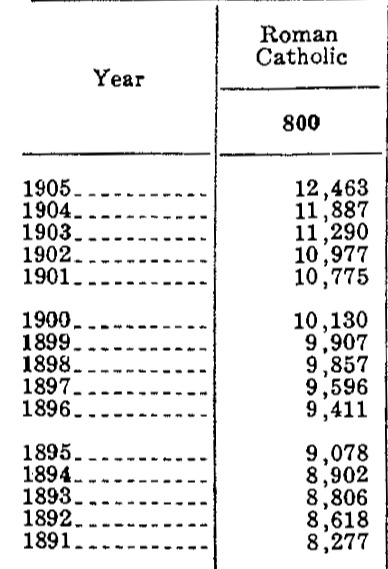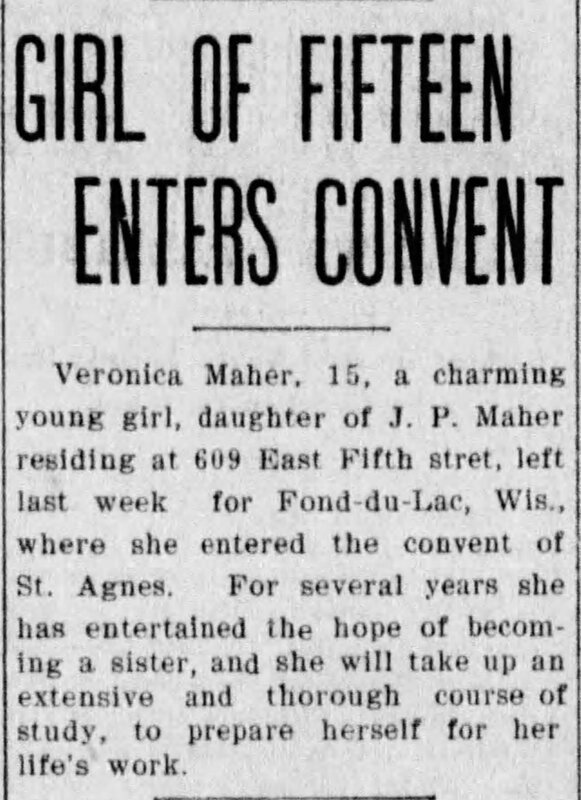The Nuns of St. Lawrence School
Often when describing priests and nuns, the word vocation is used. "Vocation" suggests something greater than work. However, the day to day experience of the Sisters of St. Lawrence was the same as any live-in working community. Moreover, their work signalled their identity as the most visible members of Muncie's Catholic community. Their work was the emblem of their identity, and their contributions ensured that the Catholic community persisted.
This biographical video was researched and created by Kdin Alba, Grace Creamer, and Griffin Hamilton.

Above: Historical Statistics of the United States: Colonial Times to 1970, Part 1 (US Department of Commerce, Bureau of the Census, 1975), 408. Table shows numbers in 1,000s.
From 1880 to 1890, the American population increased by 25%. According to the 1890 decennial census, the USA had a population of almost 63 million people. Indiana's population was almost 2.2 million, and Muncie made up 11,345 people. While the gas boom prompted an industrial expansion, which encouraged more migrants, houses, and shops, little has been written about Muncie's religious growth through this period. In 1891 the American government began counting its growing Catholic population, likely as a result of increasing immigration from Catholic countries like Italy, Ireland, Germany, Poland, and parts of the Austro-Hungarian Empire.
As the table (left) shows, in 1891 the USA counted 8.2 million Catholics, rising to 9 million in 1895. As the first nuns grew accustomed to their work in Muncie, the nation's Catholic population rose to 10.1 million in 1900 and 12.5 million in 1905. In 1910 there were 14.3 million Catholics in the USA and in 1920 there were 17.7 million.
The expansion of St. Lawrence Catholic School from the 1890s onwards, acts as a proxy for considering the Catholic community's growth. Although not all of Muncie's Catholic children attended the school, newspapers reported that in 1900 there were 115 Catholic children confirmed, in 1903 there were over 100, and in 1906 about 180 Catholic children confirmed. Through this period the teaching staff grew consistently. In 1893 the school had three nuns teaching, while in 1900 there were five nuns teaching. In 1910 the covent had grown to ten nuns. The census record below shows that they were all listed as school teachers, and lived with a lay teacher named Mary Brown. Notably, most of the nuns were native-born Americans. Only Sister Bertha was born in Canada and Sister Marcallieu was born in Ireland. While four more nuns had immigrant parents, this shows that by 1910 the American Catholic population was at least two generations old.
The relative youth of the American Catholic population, combined with its rapid growth, as well as other issues including immigrant poverty, lack of education, and growing temperance support, resulted in substantial anti-Catholic feeling. The opening of Catholic schools through the late nineteenth century highlighted Catholics as a separate community. The cartoon (left) presents a well-spoken mother sending her well-dressed children off to an American public school, accompanied by an Irish maid, whose accented English makes her preference for Catholic education seem superstitious and ignorant.
This cartoon preceeded President Grant's call for a constitutional amendment in 1875 that prohibited the use of federal funds for "sectarian" schools. While the amendment did not pass, the idea was reborn in Blaine Amendments (named after Senator Blaine of Maine). These laws passed in the next decades, and prohibited federal funding for Catholic schools in 34 state constitutions.
Nevertheless, the number of Catholic schools in America grew, along with the nation's Catholic population. Catholic schools reached a peak in the mid-1960s, and declined thereafter.
Notably, in 1901 The Muncie Evening Press published an article celebrating the new school building and its two decade history under Fr. Schmidt's direction. The article reminded readers that "the work in the parochial school is similar to that in the Muncie public schools."
In the absence of a reliable and broadbased way to think about how a predominantly Protestant community interacted with its Catholic neighbors, consider how the city reacted to its members joining the clergy. Women who took monastic vows were comparatively rare in Indiana. Although the number of nuns had grown as the American Catholic population had, there were only about 50,000 American nuns in 1900. Indiana boasted several Catholic convents in the late nineteenth century including the Sisters of St. Benedict in Ferdinand (from 1867), and the many Sisters of Providence convents at St-Mary-of-the-Woods (from 1840) and elsewhere.
There are only a few records of women taking vows preserved in Muncie newspapers. One of the earlist is an announcement from 1883 (left) about St. Lawrence's lay teachers, Miss Mary Forestal. When the mother superior from St. Joseph's convent in Cleveland visited, Forestal returned with her to start her novitiate (monastic training). The brief article is just as much focused on the quality of the schools' teaching and the nuns as teachers, as it is on Forestal's decision. There is little to suggest that contemporaries disapproved. Instead the article explains the event for curious non-Catholic readers.
More than twenty years later in 1906, another newspaper announcement appeared, publicizing Veronica Maher's decision to take monastic vows. This article (left) has a slightly different tone. Instead of balancing the news with praise for the school, the girl's age dominates the headline. Considering the period of academic and religious preparation that stretched before her, 15 years old was not out of the ordinary. In 1900 the nuns at St. Lawrence's school ranged in age from 25 to 50. The addition of a 24-year old postulant (nun-in-training), Catherine Mahoney, reveals how female students at St. Lawrence might have seen a career path in the convent. Teaching was a common profession for women in this period, and Catholic schools staffed by nuns were opening across the Midwest. While 15 years old seem young today, there were many women and men working full-time in Muncie in factories and domestic work. More likely it was the religious vocation combined with a celibate life that seemed notable to predominantly Protestant readers. For a 15-year old to make such a life-long decision surely caused conversation.
This methodology video was researched and created by Kdin Alba, Grace Creamer and Griffin Hamilton.
Click on Conclusion to reflect on what these notable lives tell us about working women in Muncie from 1870 to 1920.





